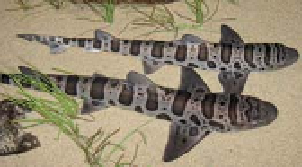Biology Reference
In-Depth Information
metabolic rate enables them to put up a sustained fight—are favorites with
sport fishermen. By the 1970s, Striped Bass had become such an integral
part of the local sport fishing economy that the state developed an index of
Striped Bass health to regulate water diversions. This well-adjusted trans-
plant remained an indicator of estuarine health until the focus shifted to
endangered fish.
Leopard Shark
he Leopard Shark (
Triakis semifasciata
) is easy to distinguish by its yel-
low eyes and the pattern of black spots and bars on its off-white skin. It is
the most abundant shark in San Francisco Bay. It can grow five feet long
over a life span of more than 20 years.
Researchers have found that Leopard
Sharks in a given group never varied in
size by more than 12 inches. No one
knows why. (Aquarium of the Bay)
The Leopard Shark spends much of its time on the bay floor shoving its
snout into the mud in search of bottom-dwellers such as shrimp, inn-
keeper worms, clams, fish eggs, and Plainfin Midshipman. It employs an
ingenious method to nab shellfish: it will grasp the neck of a clam in its
teeth and lever its long body against the bottom to yank the mollusk free
from the mud. Another favorite food is the anchovy. Instead of chasing
these tiny fish hither and yon, Leopard Sharks have been observed in San
Francisco Bay swimming counterclockwise against a tight ball of ancho-
vies schooling clockwise, so the little fish swim straight into their mouths.
In June and July, Leopard Sharks mate close to tidal marshes and then
birth up to 36 pups later in the summer, often amid the shelter of eelgrass.
For pups, it's a perilous existence—they are favored food for larger sharks,
and they are also victims of poaching for aquariums. The Leopard Sharks
that survive eventually move out from the sloughs and into open bay wa-
ters, where hungry Sevengills and sea lions await.
The Leopard Shark tends to correlate its movements with the tides,
The broad-nosed Sevengill Cowshark
(
Notorynchus cepedianus
) is named for
its great size and slow movements. The
bay's top predator can grow up to 10
feet long and 250 pounds in weight.
(Aquarium of the Bay)



